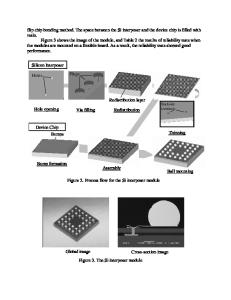Redistribution of Mn upon Annealing in Ferromagnetic Mn-implanted Si
- PDF / 237,994 Bytes
- 5 Pages / 612 x 792 pts (letter) Page_size
- 21 Downloads / 270 Views
0908-OO17-03.1
Redistribution of Mn upon Annealing in Ferromagnetic Mn-implanted Si M. Bolduc, C. Awo-Affouda, F. Ramos and V. P. LaBella∗ College of Nanoscale Science & Engineering, University at Albany-SUNY, Albany New York 12203, USA (Dated: November 21, 2005) The redistribution of implanted Mn ions in Si after thermal annealing is studied. P-type Si wafers were implanted with 300-keV Mn+ ions at 350 ◦ C to a dose of 1×1015 cm−2 , and then annealed at 800 ◦ C for 5 min. Ferromagnetic hysteresis loops were obtained at 10 K using a SQUID magnetometer both before and after annealing. The saturation magnetization increases by ∼ 2 × after the post-implant annealing, while the Mn redistributes with sharp peaks in concentration. The calculated point-defect profile created during the implantation process peaks around the Mn-depleted region, suggesting that the residual implant damage may play a role in the ferromagnetic behavior of Mn-implanted Si. INTRODUCTION
Diluted magnetic semiconductors (DMS) have been demonstrated as a successful method for integrating ferromagnetism into conventional semiconductors through doping with transition metal impurities such as Mn [1–6]. The standard model for the ferromagnetic behavior of a DMS is that it arises from the magnetic moments of the sparsely distributed substitutional Mn atoms. These exchange interaction between these moments is indirectly mediated by the positive charge carriers in semiconductors [7]. However, second phases or crystallites may also interact with the carrier charges, enhancing the magnetic properties [8–11]. Therefore, understanding the structure of the material is important for understanding the source of the ferromagnetism. Ion implantation has been demonstrated as a successful means to fabricate DMS compounds by introducing dopants in excess of the solubility limit [12–19]. For example, room temperature ferromagnetic ordering has been successfully obtained in GaP and GaN implanted with 3 at.% Mn, resulting in single-phase DMS materials [18, 19]. However, MnAs submicron precipitates buried in Mn-implanted GaAs achieved ferromagnetic behavior at room temperature, similar to bulk MnAs [9, 15–17]. This fabrication technique is attractive for Si since concentrations of ∼ 1 at.% (∼ 1020 cm−3 ) can be readily reached, which exceed the solubility limit of Mn in Si (∼ 1016 cm−3 at 1000◦ C ) [20]. The synthesis of a ferromagnetic Si-based semiconductor via Mn-ion implantation has only recently been reported [21–23]. The Curie temperature has been demonstrated to be above room temperature both before and after thermal annealing [21]. While the saturation magnetization increases following the thermal anneal, a strong redistribution of the implanted Mn ions occurs coincident with the formation of MnSi1.7 nanoscale crystallites [24–26]. These studies suggest that the room temperature ferromagnetism arises from substitutional Mn or small Mn:Mn clusters, since Mn:Si complexes such as MnSi or MnSi1.7 are paramagnetic at room temperature with Curie temperatures below 50
Data Loading...










